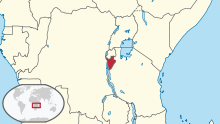July 1966 Burundian coup d'état
 Location of Burundi in Central Africa | |
| Date | 8 July 1966 |
|---|---|
| Location | Bujumbura, Kingdom of Burundi |
| Type | Military coup |
| Cause |
|
| Motive | Regime change |
| Target | Royal Palace, Bujumbura |
| Organised by | Crown Prince Charles Ndizeye Michel Micombero |
| Outcome | Coup succeeds
|
| History of Burundi |
|---|
 |
On 8 July 1966, a coup d'état took place in the Kingdom of Burundi. The second in Burundi's post-independence history, the coup ousted the government loyal to the king (mwami) of Burundi, Mwambutsa IV, who had gone into exile in October 1965 after the failure of an earlier coup d'état.[1][2]
Background[edit]
The first coup attempt had been led by members of the Hutu ethnic group and was provoked by rising ethnic tensions between the Hutu and Burundi's Tutsi ruling class. The July 1966 coup was an extreme Tutsi counter-reaction against what they saw as Mwambutsa's dangerous moderate tendencies in trying to balance Hutu and Tutsi demands in government.[3]
Events[edit]
On 24 March 1966, shortly after going into exile, Mwambutsa had delegated his royal powers to his son, the 18-year-old Crown Prince Charles Ndizeye.[4][5] On 8 July 1966, forces loyal to Ndizeye overthrew the pro-Mwambutsa government of Prime Minister Léopold Biha. Ndizeye announced that he was assuming the role of head of state of Burundi. He suspended the constitution, dismissed Biha, and asked the 26-year-old Captain Michel Micombero, a Tutsi army officer who had played a major role in the coup, to form a new government. On 12 July, Micombero's government was installed with himself as prime minister. On 1 September, Ndizeye had himself crowned as Mwami Ntare V.[6] Ntare promised to Burundi strong leadership, anti-corruption measures, and a new constitution.[2]
However, tension developed between Ntare, who wanted to actively rule as a monarch, and Micombero's government, which had aligned itself to reform and saw little need for an involved king.[7]
Aftermath[edit]
Less than five months later, Micombero led a third coup d'etat on 28 November which ousted Ntare.[8][9] Micombero abolished Burundi's monarchy and declared the nation a republic. This allowed Micombero to establish a military dictatorship with UPRONA as the only legal party, which would last until his own overthrow in a military coup in 1976.[2] Ntare V fled into exile but returned to the country from Uganda in 1972, at which time he was assassinated under circumstances that have yet to be fully explained.[10][9]
References[edit]
- ^ "Power in Burundi Seized By Absent King's Son, 21". The New York Times. 1966-07-09. Retrieved 18 January 2021.
- ^ a b c "Renversement du roi Ntare V au Burundi". Perspective monde (Université de Sherbrooke). Retrieved 23 October 2016.
- ^ Tshimba, David-Ngendo (21 January 2016). "2015 as a repeat of 1965 in Burundi: the stubbornness of political history". Thinking Africa. Retrieved 18 October 2016.
- ^ Lemarchand 1970, pp. 419–421.
- ^ Michael Crowder (1984). The Cambridge History of Africa. Cambridge University Press. pp. 737–. ISBN 978-0-521-22409-3.
- ^ Lemarchand 1970, p. 428.
- ^ Lemarchand 1970, p. 429.
- ^ "BURUNDI PREMIER SETS UP REPUBLIC; Micombero Asserts He Has Overthrown the King". The New York Times. 1966-11-29. Retrieved 18 January 2021.
- ^ a b Lemarchand 1995, p. 73.
- ^ Melady 1974, pp. 5–6.
Works cited[edit]
- Lemarchand, René (1970). Rwanda and Burundi. New York: Praeger Publishers. OCLC 254366212.
- Melady, Thomas (1974). Burundi: The Tragic years. New York: Orbis Books. ISBN 0-88344-045-8.
- Lemarchand, René (1995). Burundi: Ethnic Conflict and Genocide. New York: Woodrow Wilson Center Press. ISBN 0-521-45176-0.


 French
French Deutsch
Deutsch
